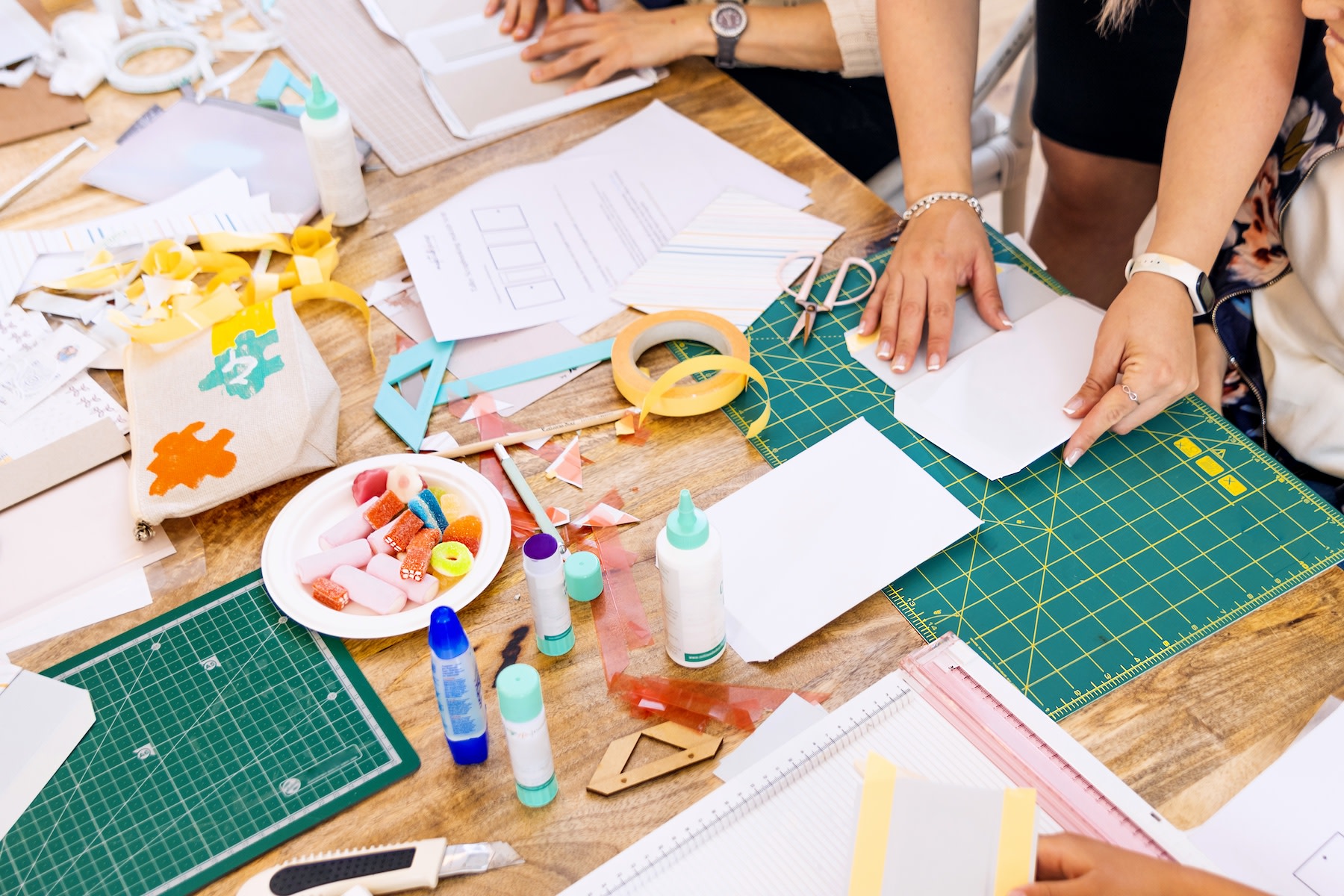
Thomas Barwick / DigitalVision via Getty Images
Vision Boarding Actually Works. Here’s How to Make One, According to the Pros
Looking for a little extra motivation to reach your wellness goals? A vision board can help.
By Kylie Gilbert•
What Is a Vision Board?
How Do Vision Boards Work?
How to Use Vision Boards to Pursue Health and Fitness Goals
What to Put on a Vision Board
How to Make a Vision Board
Feeling inspired to commit to a new goal or pursue a dream you put on the backburner, but need a little help getting started? A vision board could be just the creative refresh you need.
“I think [vision boards] are really helpful if you feel particularly unmotivated or stuck,” says Anna Laifer, an executive leadership coach whose clients include professional athletes. “It’s a way to spark something—and that can happen any time.”
But vision boarding is more than a creative outlet: The psychology behind the practice is supported by research and used by athletes to reach their performance goals. Ahead, we’re sharing expert-backed tips on how to make a vision board that feels realistic and supportive—of both where you are now and where you want to go.
What Is a Vision Board?
A vision board is a collage of images and phrases that represent your goals and aspirations. Many people use them as a form of manifestation or goal-setting.
Creating a vision board can give you clarity on your goals in all different areas of your life—your career, relationships, or health, for example—and returning to your vision board can keep you motivated and accountable along the way.
While the concept isn’t all that new, vision boards (sometimes called dream boards or mood boards) were a helpful tool for many during the COVID-19 pandemic. It was a time when lots of us felt the urge to find a hands-on creative outlet (like knitting or baking banana bread) to de-stress and get away from our screens, says Laifer, who uses visualization in her practice often.
“Vision boarding creates a sense of novelty. It’s fun, it’s playful, it’s expressive—and it’s yours,” Laifer says. “Post-COVID, we’re looking for new ways to understand ourselves and what we’re here to do.”
Creating a vision board (whether physical or digital) can help us connect with ourselves in a new way—and maybe even disconnect from Instagram a bit, Laifer adds. While social media pushes us to constantly consume other people’s lives, vision boarding allows us to be our own content creators.

DragonImages / iStock / Getty Images Plus via Getty Images
How Do Vision Boards Work?
Making a vision board might not sound like the most scientific goal-setting technique, but there’s research to back up the concepts behind the practice, says Alan Chu, PhD, an associate professor of applied sport psychology at UNC Greensboro and a certified mental performance consultant who works with athletes and coaches on mental skills training, including goal setting and visualization.
Imagery, or creating an experience in your mind, is a tool that sports psychologists use with athletes to enhance their performance. It works by triggering the same parts of the brain that are activated when you actually perform the task, a concept known as “functional equivalence,” Chu explains.
“For example, if I imagine myself shooting a free throw in a championship and then winning the championship, I’m activating the same neural pathway as I would playing an actual game,” he says. Imagery involves using all your senses to create an image as realistically as possible: the sound of the crowd, the texture of the basketball in your hand, the taste of the sports drink you’re sipping, or the smell of sweat, Chu says by way of example. It’s also about your thoughts and emotions—imagining yourself having the butterflies, for instance.
A study of 65 tennis players published in Basic and Applied Social Psychology suggests the effectiveness of imagery. In the study, participants who were tasked with improving their tennis skills and outperforming other players did better after being prompted to imagine the experience of completing 20 serves and hitting the target line every time.
Essentially, imagery embodies the “if you believe it, you can achieve it” adage—and this is exactly what vision boards can tangibly provide. “An image can capture a thousand words. They allow us to get out of our logical brain and into more of an intuitive, emotional, felt sense of self,” Laifer says.
And just as some of us are visual learners, some of us are also “visual connectors,” Laifer adds. For example, an image of you sitting on the beach feeling peaceful in nature may resonate more than writing down the words, “I want to feel peaceful and present in nature.”
How to Use Vision Boards to Pursue Health and Fitness Goals
Specifically focused on achieving a new wellness goal? Vision boards can help you get there—but first, you have to set goals that feel realistic and right for you.
Chu suggests using a goal-setting technique called WOOP, which involves thinking about your wish (what you want to happen), outcome (how it’ll feel to meet this goal), obstacle (things that could throw you off course), and plan (how you’ll overcome those obstacles). On your vision board, make sure you acknowledge the plan and obstacle aspects you’ll face along the way, not just the outcome or wish, Chu suggests.
For example, if your goal is to run a marathon, think beyond the finish line moment when making your vision board, Laifer says. “In reality, training for a marathon is about the little moments—the months and months of daily training,” she says. “So, maybe you include an image of morning dew on the grass or a sunrise that represents that commitment to taking the steps to run a marathon.”
Related Articles

Mental Health
Want to Start Journaling, but Unsure Where to Begin? Follow These Pro Tips to Make the Habit Stick

Meditation
What Is Manifestation, and Does It Actually Work? We Asked Mental Health Experts

Mindset
Affirmations Really Work—Here’s How to Use Them to Reach Your Personal Goals

Mindset
A Step-by-Step Guide to Setting Intentions (and Sticking to Them)
Experts say the key to maintaining long-term determination to reach your goals is to tap into intrinsic motivation—aka the “why” behind your dream. “It’s not the vision your parents have for you. It’s not the vision your coach has for you. It comes from you,” Chu says. Ensure your vision board reflects how you want to feel and what values drive you to achieve your goals beyond external validation, Chu says.
All this imagery and reflection on your vision board can help you reach your goals by changing the way you see yourself. “Instead of thinking about yourself being able to run a marathon, it’s seeing and imagining yourself as a runner,” Chu says. “When we have that sense of identity, we are more likely to believe we can achieve our goals rather than doubting ourselves—a vision board is powerful in that sense.”
What to Put on a Vision Board
You can put anything you want on your vision board, but a good starting point is to choose images or words that “represent something either aspirational or inspiring to you,” Laifer suggests.
Turning to images or quotes from role models that inspire you is one place to start, Chu suggests. For example, if you’re an aspiring tennis player, maybe it’s a picture of Naomi Osaka at the US Open.
Images representing connection and belonging may help keep you intrinsically motivated, too, Chu notes. Think: a picture of someone running with a group of friends, or two hands intertwined, for instance.
While a stack of magazines is great source material, you can also add your own photos and mementos that tie into your goals or aspirations. Hand-written notes that include phrases, words, quotes, or affirmations that resonate with you are also fair game.
You can also make multiple vision boards for different aspects of your life. “Let go of the expectation that this vision board is going to perfectly represent every goal you have and let yourself have fun with it,” Laifer says.

Alfonso Soler / iStock / Getty Images Plus via Getty Images
How to Make a Vision Board
There’s no correct way to make a vision board—it’s not intended to be a rigid process, Laifer says—but here are a few tips that can help guide you along:
1. Consider Vision Boarding in a Group
While vision boarding can certainly be a solo exercise, Laifer suggests seeking out a small group for the exercise. It can be beneficial to talk about your vision boards out loud—and seeing that no one else is (likely) a professional artist either may help you be less self-critical.
2. Don’t Strive for Perfection
You don’t have to have a neat explanation for everything on your vision board. Sometimes, you may not know why you’re drawn to a particular image until weeks later, Laifer says.
When it comes to actually creating your collage, know that you can make a physical vision board with cardboard and glue, or a digital vision board using your preferred design tool. Either way, don’t overthink the arrangement. “The beauty is each person does it their own way,” Laifer says. “There’s no right or wrong. It’s more about whatever feels good and whatever it wants to be for you.”
3. Put It Somewhere You’ll See It
To get the most out of your vision board, Chu suggests putting your finished product somewhere where you’ll see it every day, such as above your desk or mirror.
If you’re trying to achieve a health and wellness goal, consider putting it near your running shoes or in the area of your home where you exercise, Laifer suggests. (Think: the “Believe” sign hung in the locker room on Ted Lasso.)
4. Return to Your Vision Board Often
There’s no rule that says vision boards have to coincide with the new year or a new season—they can be helpful anytime you need a little extra motivation or want to reconnect with yourself.
“Give yourself permission to either add to your vision board or update it,” Laifer says. If a new word keeps showing up in your life, or you find yourself drawn to a particular image, add it to the top of your vision board. “It can grow and evolve as you keep growing and evolving,” she adds.

Peloton App
Access thousands of classes with no equipment needed.
This content is for informational and educational purposes only and does not constitute individualized advice. It is not intended to replace professional medical evaluation, diagnosis, or treatment. Seek the advice of your physician for questions you may have regarding your health or a medical condition. If you are having a medical emergency, call your physician or 911 immediately.
Strengthen your mind-body connection
Enter your email to get articles, expert-backed tips, and updates from Peloton sent to your inbox.
By providing your email address, you agree to receive marketing communications from Peloton.
For more about how we use your information, see our Privacy Policy.


